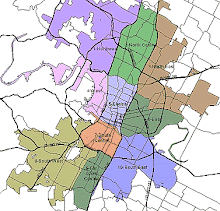I remember reading that the City was going to complete the hike and bike trail around Town Lake* for $1.5 million, and that many citizens were perturbed by such actions. Well, folks, such actions cost money, and unless you think that creating more walkable trails is a bad thing, you should probably learn how to cope. One evening I was having dinner with friends and one mentioned disdain about the light rail being expensive and not going south of the river. "You know," I said, having attended a meeting full of people who gave their opinions of the light rail, "many people south of the river mentioned that they didn't want the noise, even though everyone knows that light rail increases property value." My friends were stunned, and the room was quiet. "The noise? There were car/rail accidents in Houston because the rail cars were too quiet, and the engineers had to add noise to the trains. The noise?" asked one of my other friends.
Bottom line: light rail serves as a public good, and rich and poor people will ride it. True, it will require a modicum of spending and regulation, but that is nothing new to a state full of highways, universities, and real estate development. All public goods cost money, but using price as excuse to keep cities antiquated continues to divide the rich from the poor. Rich people are happy to pay hundreds of dollars a month for the privilege of sitting in traffic, while poorer people remain in debt and sacrifice food and living space for said "privilege." Not building up light rail constitutes continuing to choose for people, instead of letting them choose for themselves.
Another question to posit to opponents of rail is this: how much money do roads make and how much do they cost? In other words, where is my check from IH-35? Roads in and of themselves are not businesses earning profit. If one logs in to the TxDOT website, the meetings are videotaped and broadcasted online, and all discussions are about how highways will be funded. What is evident throughout these meetings, which rarely have any mention of public transit, is that TxDOT is about highways, not about all types of transportation. Highways mean money for specific contractors, auto makers, and oil companies. They do very little for citizens except perpetuate bad planning practices, and they cost a staggering amount of money to build and maintain.
Light rail, and particularly commuter rail, offers an extraordinary opportunity for economic viability in smaller towns. Towns and neighborhoods that are normally bypassed by highways to maximize travel routes can become popular daytrips that encourage the gestation of local businesses. There are so many people who live in smaller towns and commute to larger towns that rail centers would provide business opportunities for restaurants, movie theatres, or even college satellite campuses. In Box Hill, a city in southeast Australia, the Asian-Australian community has solidified downtown into a cultural experience that one can get to easily and affordably, which has boosted real estate value and has expanded additional local businesses. Our own Fredericksburg has expanded tremendously, and what would be better than allowing people to avoid gas and parking, and just go to Fredericksburg - or New Braunfels, for that matter, which has invested greatly in its downtown area - and enjoy their community events and businesses, and then take a train right back to Austin? Or how about just hopping on a train from the Mueller Development to enjoy South by Southwest?
Finally, more people have taken on second jobs to pay bills and as good as the bus system is, getting across town at night is difficult and takes a long time. Many people end up using the money from their second jobs just to get to them, and the situation will continue to worsen as this economy sets itself for employers, not employees. Work is essential to keep our economy moving, and rail is a method of transportation that allows people to work and to get to work more easily. Discussing transportation for workers and not discussing rail is like two people trying to clear a field with a pair of scissors and a machete: the task can be done, but it will most likely take a long time.
Light rail moves people more easily around cities, and the cost of constructing it will only rise in the coming years. We need to invest now so that Austin remains one of the greatest cities in Texas, and to lower at least part of the cost of living here. $500 a month to keep a car running is no longer cutting edge technology.
Saturday, February 7, 2009
Subscribe to:
Post Comments (Atom)

No comments:
Post a Comment